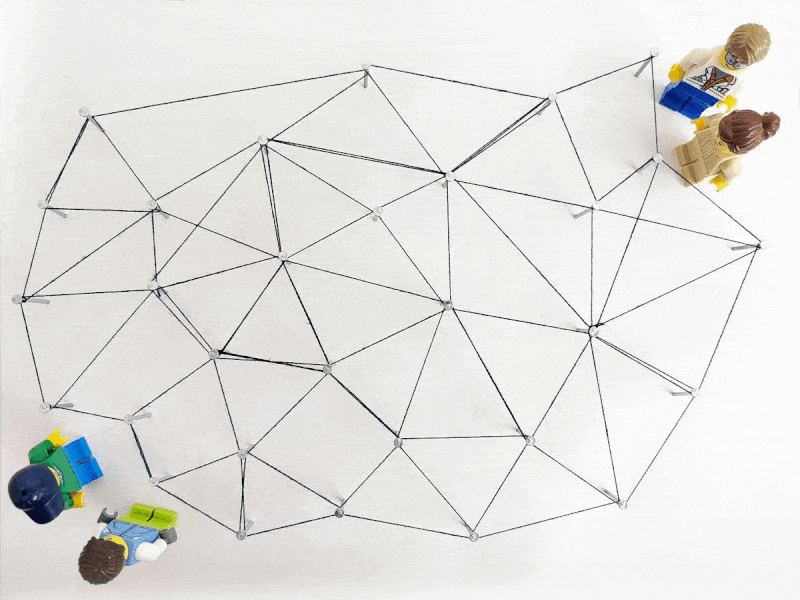
Mesh networks handle routing by using a peer-to-peer communication system, where each node (or device) in the network acts as both a sender and a receiver of data. And there’s much more to it than just that. A particular way in which a network operates in a selected environment can ensure successful data transmission, keep the network up and running 24/7, reduce latency and increase reliability.
For example, in a facility with mobile robots, the network connecting them must be flexible. Allowing multiple routing paths ensures seamless communication by redirecting data through alternate paths if a robot’s movement obstructs the original communication path.
A deep dive into the Meshmerize multipath mesh routing

Network characteristics dictate mesh routing protocols
Routing is the most important job of a mesh network. Depending on the type of the network, there are various ways a packet can be sent from one node, through others, to the destination node. Whether the nodes are static or dynamic, changes the requirements drastically.
Proactive protocols maintain a sequence of nodes from the first to the last in the path. The downside is that they are susceptible to failure anytime any of the nodes in the sequence moves or goes offline. Reactive protocols search for a route every time a packet needs to be sent, which can lead to network congestion. They can also be slow to converge in the event of a network change or failure, which can cause packet loss and delays.
A dynamic routing protocol for a dynamic network
In a dynamic mesh network, routing data can be challenging as the network is constantly changing and the best path for data to travel may not always be clear. The way Meshmerize approaches this issue is through multi-path routing.
Unlike traditional routing protocols, where packets are sent along a single best path to the destination, Meshmerize sends packets along multiple paths simultaneously. This improves network reliability, as even if one path fails, the packet can still reach its destination through another path.

The hopping of the data ball
Imagine a room with 30 people and a big green ball that needs to be passed from one side of the room to the other. In a traditional routing protocol, the ball would be passed from person to person, following a predetermined list of names (nodes) to throw to. This method carries a certain level of risk. It relies on a single route and could be disrupted if any individual along the way makes a change.
Meshmerize operates differently. Instead of throwing the ball to one person, the sender makes multiple copies of the ball and sends them to the neighboring nodes, in the direction of the receiver. Each time a ball hops to the next person (node), it gets copied again and again.

Meshmerize does not blindly send these copied packets in all directions. Instead it smartly chooses the directions that have the highest probabilities of reaching the destination quickly. This ensures that multiple copies of the ball reach the destination, while also being fast and optimized.
Handling copied balls is an easy task. The first copy received at the destination will be identified as task completion and the duplicates would be discarded.

Are we polluting the network?
The real issue is the limited capacity and bandwidth available. In our example, there is a limited number of hands available for throwing balls. This is not an issue if there’s only one ball to be passed from one source to a destination. But what happens if someone else needs to pass a blue ball? And someone else a red one? Then quickly everyone is juggling multiple balls and getting confused. Meshmerize handles this by smartly balancing throughput and reliability, making smart decisions on data duplication.
Our multi-path routing handles transmissions efficiently, even with high volumes of data packets. Levels of prioritization within the network are also created based on the characteristics of the data packet itself.
So, small data packets will be sent in multiple copies and at a faster rate, taking required reliability into account. On the other hand, for example big bulky video data that consumes more network resources, but requires less reliability, will be made in fewer copies to ensure the necessary throughput for the whole network. This minimizes network pollution, at the same time making efficiency and dependability top priorities.

Smart use of redundancy for a reliable mesh routing
The main thing that sets Meshmerize apart from other mesh network software is multiple paths created for packet transmission. The focus is on reliability, not throughput.
This trade-off makes it especially convenient for various dynamic network environment use cases. There, reliability has an essential role in getting work done, on time and without headaches.
For performance optimization and achieving desired results, it may be necessary to prioritize certain features over others. The multi-path routing approach allows for the most efficient use of a mesh network in dynamic environments, such as intralogistics, mobile robotics, drone swarms, autonomous construction and agricultural machinery. By focusing on the most valuable features, Meshmerize makes it possible to improve overall performance.
Meshmerize is a startup based in Dresden, Germany that provides the ultimate mesh network software to an array of industries. The potential of Meshmerize is yet to be seen. We would like to hear your thoughts – let us know what you think at hello@meshmerize.net






